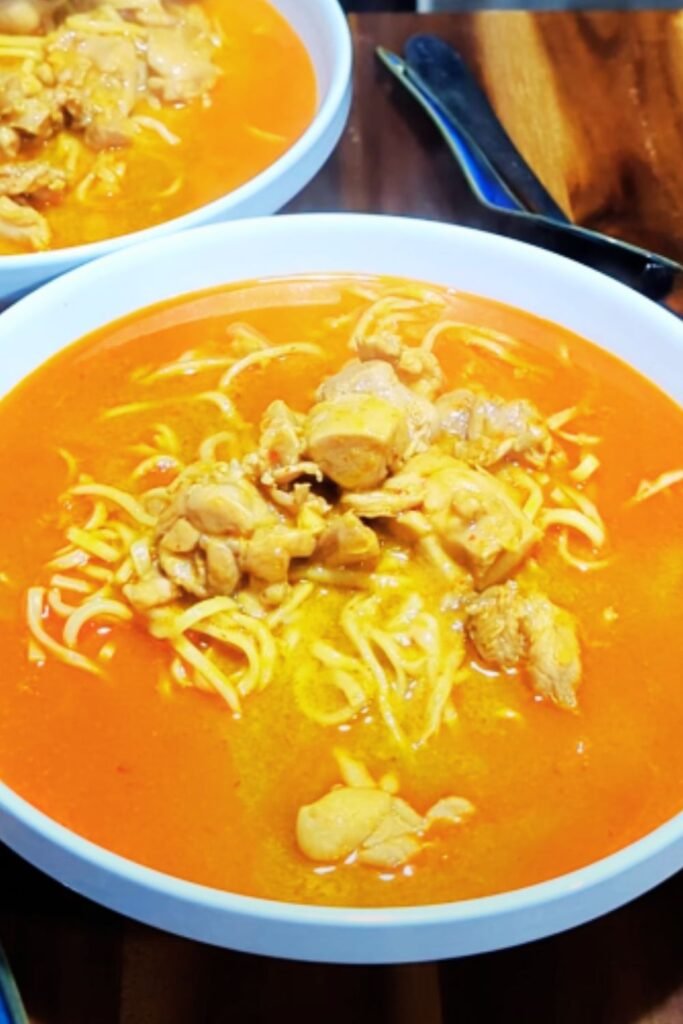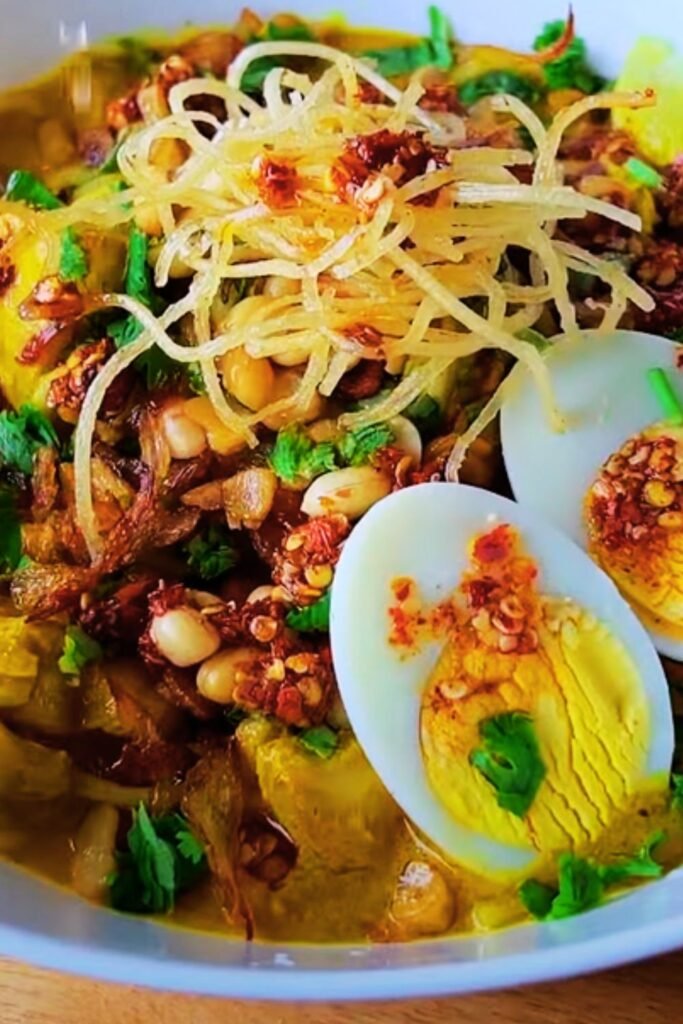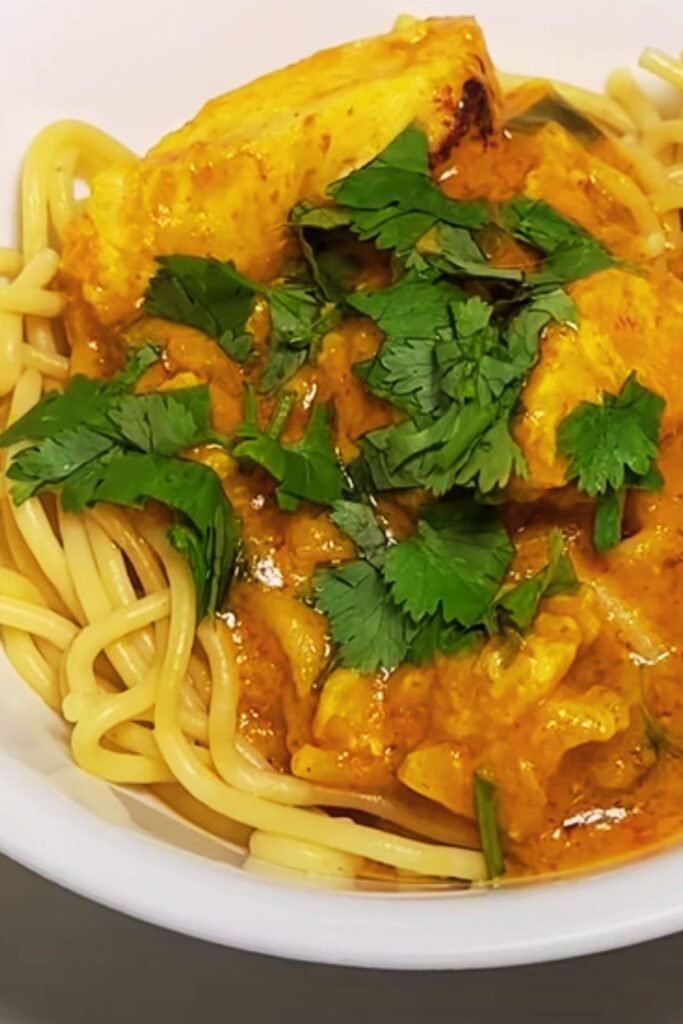When I first traveled to Chiang Mai five years ago, I stumbled upon a small street-side stall where an elderly woman was ladling golden, aromatic curry over fresh egg noodles. That bowl of Chicken Khao Soi changed my entire perspective on Thai cuisine. The complex layers of flavor, the perfect balance of textures, and the soul-warming comfort it provided made me realize I had to master this dish.
Chicken Khao Soi isn’t just another curry noodle soup – it’s a culinary masterpiece that represents the heart of Northern Thai cuisine. This Burmese-influenced dish combines the richness of coconut curry with the satisfying texture of both soft boiled noodles and crispy fried ones, creating a symphony of flavors that dance on your palate.
What Makes Khao Soi Special
Khao Soi (ข้าวซอย) literally translates to “cut rice,” though the dish primarily features wheat-based egg noodles. This seemingly contradictory name reflects the dish’s complex cultural heritage, influenced by Chinese traders, Burmese migrants, and local Thai traditions.
Northern Thai Curry Paste: The foundation of authentic Khao Soi lies in its unique curry paste, which differs significantly from other Thai curries by incorporating dried chilies, galangal, and shallots in specific proportions.
Coconut Milk Balance: Unlike many Thai curries that use coconut milk as a base, Khao Soi requires a careful balance between thick coconut cream and thinner coconut milk to achieve the perfect consistency.
Dual Noodle Texture: The genius of Khao Soi lies in serving both soft boiled noodles in the curry and crispy fried noodles on top, creating textural contrast in every spoonful.
My Essential Ingredient List
After countless attempts and recipe refinements, I’ve identified the crucial components that make or break a Khao Soi dish. Here’s what you’ll need:
For the Curry Paste
- 8 dried red chilies (preferably New Mexico or Guajillo)
- 3 shallots, roughly chopped
- 6 garlic cloves
- 2-inch piece of galangal, sliced
- 1 stalk lemongrass, tender part only
- 1 teaspoon coriander seeds
- 1/2 teaspoon cumin seeds
- 1 teaspoon shrimp paste
- 1 teaspoon salt
For the Curry
- 2 pounds chicken thighs, bone-in, skin-on
- 1 can (14 oz) thick coconut cream
- 2 cans (14 oz each) coconut milk
- 3 tablespoons curry paste (from above)
- 2 tablespoons palm sugar
- 3 tablespoons fish sauce
- 2 tablespoons dark soy sauce
- 1 tablespoon light soy sauce
- 2 cups chicken stock
For Serving
- 1 pound fresh egg noodles (or 12 oz dried)
- Oil for deep frying
- Lime wedges
- Sliced red onions
- Pickled mustard greens
- Crushed dried chilies
- Fresh cilantro

Nutritional Profile of Chicken Khao Soi
| Nutrient | Per Serving (1 bowl) | % Daily Value |
|---|---|---|
| Calories | 680-750 | 34-38% |
| Protein | 35-42g | 70-84% |
| Carbohydrates | 48-55g | 16-18% |
| Fat | 38-45g | 58-69% |
| Fiber | 4-6g | 16-24% |
| Sodium | 1,200-1,400mg | 52-61% |
| Vitamin C | 15-20mg | 17-22% |
| Iron | 4-6mg | 22-33% |
| Calcium | 120-150mg | 12-15% |
Regional Variations Across Northern Thailand
| City/Region | Key Differences | Spice Level | Unique Elements |
|---|---|---|---|
| Chiang Mai | Original style, balanced flavors | Medium | Pickled mustard greens, lime |
| Chiang Rai | Slightly sweeter, more coconut | Mild-Medium | Extra palm sugar, fewer chilies |
| Mae Hong Son | Burmese influence stronger | Hot | Additional turmeric, stronger shrimp paste |
| Nan Province | Earthier flavor profile | Medium-Hot | Local herbs, darker curry color |
| Lampang | Noodle variations common | Medium | Sometimes uses rice noodles |
My Step-by-Step Cooking Method
Creating the Perfect Curry Paste
I always start by making my curry paste from scratch because store-bought versions simply can’t match the depth of flavor you achieve when grinding your own spices.
First, I soak the dried chilies in warm water for 20 minutes until they soften completely. Meanwhile, I toast the coriander and cumin seeds in a dry pan until fragrant – this usually takes about 2-3 minutes over medium heat.
In my food processor, I combine the drained chilies, toasted spices, shallots, garlic, galangal, lemongrass, shrimp paste, and salt. I process everything until it forms a smooth paste, adding a tablespoon of water if needed. The key is patience – this process takes about 5-7 minutes of continuous processing with occasional scraping down the sides.
Building the Curry Base
Now comes the critical part that took me several attempts to master. I heat a large pot over medium heat and add about 1/2 cup of the thick coconut cream. I let it simmer and separate until I can see oil forming on the surface – this is crucial for developing the curry’s characteristic richness.
I add 3 tablespoons of my homemade curry paste to the separated coconut cream and fry it for 3-4 minutes until incredibly fragrant. The kitchen should smell absolutely amazing at this point.
Next, I add the chicken pieces and brown them on all sides. This takes about 8-10 minutes and helps seal in the flavors while adding depth to the curry.

Simmering to Perfection
I pour in the remaining coconut cream, coconut milk, and chicken stock. Then I add the palm sugar, fish sauce, dark soy sauce, and light soy sauce. The dark soy sauce is particularly important as it gives Khao Soi its characteristic deep golden color.
I bring everything to a gentle boil, then reduce the heat and let it simmer for 45 minutes to 1 hour. The chicken should be tender enough to fall off the bone, and the curry should have a rich, complex flavor that balances sweet, salty, and spicy elements.
Preparing the Noodles
While the curry simmers, I prepare both types of noodles. For the boiled noodles, I cook them according to package directions until just tender – I prefer them slightly al dente since they’ll continue cooking slightly in the hot curry.
For the crispy noodles, I heat oil to 350°F (175°C) and fry small portions of fresh noodles until golden and crispy. This usually takes 2-3 minutes per batch. I drain them on paper towels and set aside.
Flavor Profile Analysis
| Taste Element | Intensity (1-10) | Source Ingredients | Balancing Notes |
|---|---|---|---|
| Sweetness | 6-7 | Palm sugar, coconut milk | Balances heat and saltiness |
| Saltiness | 7-8 | Fish sauce, soy sauce | Enhances umami depth |
| Spiciness | 5-7 | Dried chilies, curry paste | Varies by preference |
| Richness | 8-9 | Coconut cream, chicken fat | Creates mouthfeel |
| Acidity | 3-4 | Lime juice, pickled vegetables | Cuts through richness |
| Umami | 8-9 | Shrimp paste, fish sauce | Provides savory depth |
Traditional Serving Ritual
In Northern Thailand, serving Khao Soi is almost ceremonial. I’ve learned to embrace this tradition in my own kitchen. I place the soft noodles in the bottom of each bowl, ladle the curry and chicken over top, then garnish with crispy noodles, sliced red onions, and fresh cilantro.
The accompaniments are crucial – I always serve lime wedges, pickled mustard greens, sliced red onions, and crushed dried chilies on the side. Each diner customizes their bowl according to their taste preferences.

Common Mistakes I’ve Made (And How to Avoid Them)
Through my journey of perfecting this dish, I’ve made numerous mistakes that taught me valuable lessons:
Mistake 1: Using regular coconut milk instead of separating thick cream from thin milk. This results in a watery curry that lacks the characteristic richness.
Solution: Always use thick coconut cream for frying the curry paste and building the base.
Mistake 2: Not toasting the spices before grinding. This creates a flat, one-dimensional curry paste.
Solution: Always toast whole spices until fragrant before grinding.
Mistake 3: Overcooking the crispy noodles. Burnt noodles add bitterness to the dish.
Solution: Fry noodles in small batches and watch them carefully – they go from perfect to burnt very quickly.
Mistake 4: Adding lime juice directly to the curry. This causes the coconut milk to curdle.
Solution: Serve lime wedges on the side for individual addition.
Seasonal Ingredient Substitutions
| Original Ingredient | Season | Substitute | Flavor Impact |
|---|---|---|---|
| Fresh galangal | Winter | Dried galangal (1/3 amount) | Slightly less aromatic |
| Palm sugar | Year-round | Brown sugar | Less complex sweetness |
| Fresh chilies | Summer | Dried chilies (soaked) | More concentrated heat |
| Fresh lemongrass | Spring/Summer | Lemongrass paste | Similar citrus notes |
| Pickled mustard greens | Year-round | Sauerkraut | Different acidity profile |
Storage and Reheating Tips
Khao Soi actually improves in flavor after sitting overnight, making it perfect for meal prep. I store the curry and noodles separately in the refrigerator for up to 4 days. The curry keeps its flavor beautifully, though you may need to add a splash of coconut milk when reheating to restore the proper consistency.
I never store crispy noodles with the curry – they lose their crunch immediately. Instead, I make fresh crispy noodles each time I serve leftovers, or I store them in an airtight container for up to 2 days.
When reheating, I warm the curry gently over low heat, stirring occasionally. I avoid microwaving as it can cause the coconut milk to separate unpleasantly.
Health Benefits and Considerations
Chicken Khao Soi offers several nutritional benefits when enjoyed as part of a balanced diet. The chicken provides high-quality protein essential for muscle maintenance and repair. Coconut milk contains medium-chain triglycerides (MCTs), which some studies suggest may support metabolism.
The curry paste ingredients – particularly galangal, garlic, and chilies – offer anti-inflammatory compounds. Galangal has been used in traditional medicine for digestive support, while garlic provides immune-boosting properties.
However, I always remind people that Khao Soi is calorie-dense due to the coconut milk content. One serving provides substantial calories, making it ideal as a complete meal rather than an appetizer.
My Serving Suggestions and Pairings
I love serving Khao Soi as the centerpiece of a Northern Thai feast. It pairs beautifully with lighter dishes that balance its richness:
Som Tam (green papaya salad) provides fresh, acidic contrast that cleanses the palate between spoonfuls of rich curry.
Larb Gai (chicken salad) offers fresh herbs and lime that complement the warm spices in Khao Soi.
Fresh cucumber slices and blanched vegetables help cut through the coconut richness.
For beverages, I recommend Thai iced tea, fresh coconut water, or jasmine tea. These drinks complement the spices without competing with the complex flavors.
Questions and Answers
Q: Can I make Khao Soi without chicken? I absolutely recommend trying vegetarian versions! I substitute firm tofu or mixed vegetables like eggplant and green beans. Use vegetable stock instead of chicken stock and increase the mushroom soy sauce for umami depth.
Q: How spicy is traditional Khao Soi supposed to be? Authentic Khao Soi ranges from mild to medium heat. It should warm your palate without overwhelming the other flavors. I adjust the chilies based on my guests’ preferences, but the dish shouldn’t be painfully hot.
Q: What’s the difference between Khao Soi and other Thai curries? Khao Soi is unique because it’s served with noodles rather than rice, uses both soft and crispy noodles, and has a specific blend of Burmese and Northern Thai influences. The curry paste also differs from green, red, or yellow curry pastes.
Q: Can I use store-bought curry paste? While homemade paste produces superior results, you can use store-bought Khao Soi paste if available. Look for brands from Northern Thailand or make your own by mixing red curry paste with additional galangal and shallots.
Q: How do I prevent the coconut milk from curdling? Keep the heat at medium-low when adding coconut milk, stir gently rather than vigorously, and avoid adding acidic ingredients directly to the hot curry. Add lime juice at serving time.
Q: What type of noodles work best for Khao Soi? Fresh egg noodles are traditional and provide the best texture. If unavailable, dried egg noodles work well. Avoid rice noodles as they don’t provide the proper texture contrast.
Q: Can I freeze Khao Soi curry? I successfully freeze the curry base for up to 3 months. However, coconut milk can separate when frozen, so I whisk it well when reheating and sometimes add fresh coconut milk to restore the texture.
Q: Why does my Khao Soi taste bland compared to restaurant versions? This usually indicates insufficient curry paste, under-seasoned base, or skipping the step of frying the paste in separated coconut cream. Also, ensure you’re using enough fish sauce and palm sugar for depth.
Q: How can I make Khao Soi less rich? I reduce the coconut cream and increase the chicken stock ratio. You can also serve smaller portions with more vegetables and herbs, or use light coconut milk for part of the recipe.
Q: What’s the secret to perfect crispy noodles? The oil temperature is crucial – too cool and they absorb oil, too hot and they burn. I maintain 350°F and fry small amounts at a time. The noodles should puff and turn golden within 2-3 minutes.
Creating authentic Chicken Khao Soi has become one of my greatest cooking achievements. This dish represents more than just a recipe – it’s a connection to Northern Thai culture and a testament to how food can transport us across continents. Every time I make it, I remember that first magical bowl in Chiang Mai and feel grateful for the journey that brought this incredible dish into my kitchen.
The key to mastering Khao Soi lies in understanding that each element serves a purpose in creating the final harmony of flavors and textures. From the carefully balanced curry paste to the dual noodle presentation, every component contributes to an experience that’s both comforting and exciting. I encourage you to embrace the process, make it your own, and share this beautiful dish with people you care about.